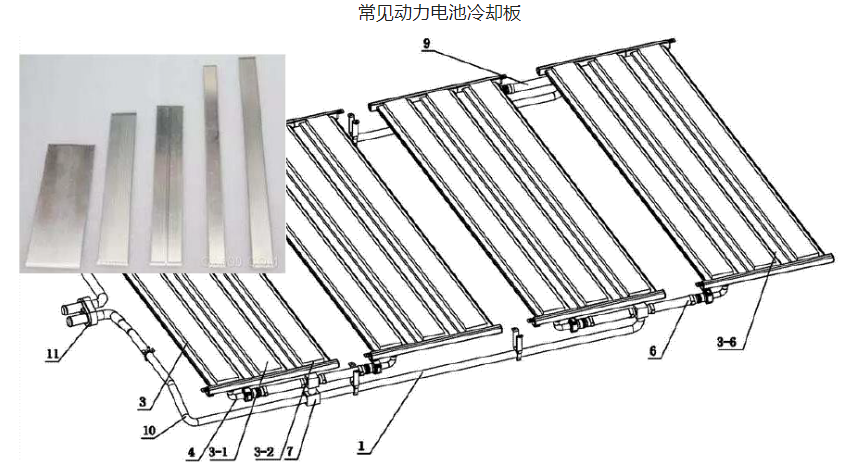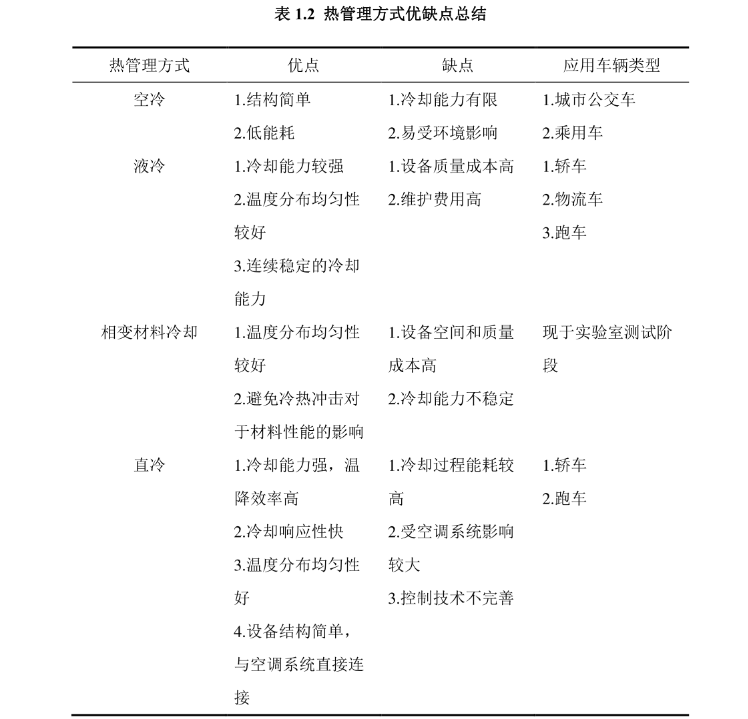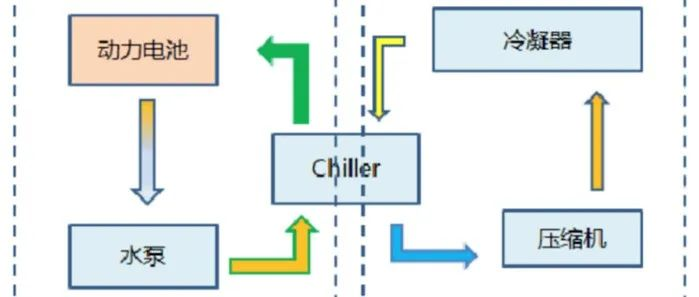Author: Su Qin
Since the entry of lithium-ion batteries into the market, they have been widely used due to their advantages of long service life, large capacity, and no memory effect. However, with the increasing frequency of using lithium batteries, there are frequent phenomena such as low capacity, severe attenuation, poor cycle performance, and lithium unbalanced discharge in low-temperature situations.
The cooling system of the new energy power battery pack is not only a major factor restricting the charging rate, but also the “culprit” affecting the cooling rate of the new energy power battery pack. Therefore, battery thermal management is one of the key technologies for electric vehicles, and battery thermal control management technology affects the safety, range, service life, and fast charging ability of power batteries, thereby controlling the temperature environment of the battery pack (PACK) and its impact on the reliability, lifespan, and energy absorption of battery cells.
Several Stages of Thermal Management for Power Batteries
Currently, the thermal management system of the power battery system can be mainly divided into four types: natural cooling, air cooling, liquid cooling, and direct cooling, which are achieved through cooling and heating. Among them, natural cooling is a passive thermal management method; air cooling, liquid cooling, and direct cooling belong to active (heat dissipation), and there are differences between them, mainly due to the different heat transfer media.

Air Cooling
In the air cooling mode, cold air is used as the medium to reduce the temperature of the battery through heat convection (natural wind, fans, and the evaporator provided by the car), thereby achieving the purpose of heat dissipation. This system has a simple structure, is easy to maintain, and was widely used in the early stages of the electric passenger car market, such as Nissan’s LEAF and Kia’s Soul EV. It has been widely used in electric buses and electric logistics vehicles before.
Compared with air-cooling technology, the heat exchange coefficient between air-cooled technology and the surface of the battery is relatively low, and coupled with the difficulty in designing a sealed battery box with poor dust and water resistance, the cooling and heating speed is slow. The temperature distribution inside the battery box is also uneven and uncontrollable, so it has been abandoned.
Water Cooling
The water cooling system mainly consists of an electronic water pump, a heat exchanger, a battery heat sink, a PTC heater and an expansion water tank. Water cooling technology is a cooling technology based on liquid exchange. A heat sink is generally used in combination with a refrigeration cycle, which takes away the heat generated by the battery through refrigerant. This mode is superior to air cooling technology and integrates with the vehicle’s cooling system to achieve fast cooling and heating speed, high exchange system between battery walls, and more uniform temperature distribution inside the electric vehicle battery pack.

However, the disadvantages of the water cooling technology system are quite significant, including a complex system, heavy weight, difficult maintenance and repair, and the possibility of leakage.
Currently, cars that use water cooling technology include Tesla and other brand models. For example, Tesla Model S has further optimized the battery arrangement, thermal management system, and battery management system to provide cooling and reduce the risk of battery self-ignition. Its liquid cooling system cools each battery cell individually to achieve lower temperatures.
Liquid CoolingLiquid cooling technology mainly achieves the cooling effect of the battery system by cooling liquid. The cooling liquid is forced to cool down by equipment such as a condenser and compressor. After the low-temperature cooling liquid exchanges heat with the battery cells inside the battery system, it flows back to the heat exchanger and exchanges heat with the low-temperature refrigerant, thus bringing back the heat generated by the battery to the battery system. Therefore, the advantage of the liquid cooling system is more flexible, as a single battery or module can be immersed in liquid, or cooling channels can be set between battery modules and cooling plates can be set at the bottom of the battery. It should be noted that when the battery is in direct contact with the liquid, the liquid must be kept insulated, otherwise it will cause a short circuit problem. However, liquid cooling technology has high requirements for the airtightness of the liquid cooling system, and mechanical strength, shock resistance, and service life need to be considered.

However, there are still some challenging issues in the liquid cooling technology used in mainstream electric vehicle battery thermal management systems, such as:
(a) Poor thermal balance: In principle, the liquid cooling method belongs to the temperature difference heat exchange principle and cannot avoid the temperature difference problem inside the battery module. The temperature difference causes issues such as overcharging, over-discharging, and insufficient charging and discharging processes during different single cell charging and discharging processes, resulting in unsafe battery performance and short battery life.
(b) Heat exchange power limited: Since controllable temperature difference is inseparable from the environment, the liquid cooling heat exchange power of the cooling plate is related to the temperature difference and flow rate. When the charging and discharging speed of the battery is limited by the heat dissipation rate, there is a risk of thermal runaway.
(c) High risk of thermal runaway: Due to the limited heat dissipation rate of the battery unit in a short time based on the temperature difference, the positive cycle between heat generation and temperature rise will cause combustion and explosion, and thermal runaway is likely to occur.
(d) High parasitic power consumption: The liquid cooling circulation resistance is large, and the flow rate is large when the heat exchange capacity is large, resulting in large circulation pressure loss and power consumption, which reduces the battery’s range.Currently, liquid cooling is the preferred solution for many electric vehicles, and adopting a liquid-cooled cooling solution is also the “must-competitive area” for many industries.
On August 12th, Green Source held the “Liquid-Cooled Ultra-Long Range 2.0 Quality China Tour” press conference, announcing the official launch of the new generation of ultra-long range electric vehicles, the Liquid-Cooled Ultra-Long Range 2.0 series, which effectively improves the service life of electric vehicles and easily achieves ten years of non-depletion for a single car. NIO plans to launch liquid-cooled super fast charging piles successively this year. Even the Internet giant Alibaba plans to use liquid cooling to replace air cooling within 3-5 years and make liquid cooling the default configuration for servers. Huawei also plans to continuously explore the direct cooling problem around data centers and use liquid cooling solutions and cooling systems for heat dissipation.
From the perspective of battery development, the air-cooled and water-cooled technologies have become a thing of the past, while liquid cooling technology is in progress, and direct cooling technology is the future.


Why is direct cooling the future mainstream?
Let’s talk about the principle first: The principle of refrigerant direct cooling technology is very similar to that of air conditioning. Both use a compressor to compress refrigerant gas into high-temperature and high-pressure gas. Then, after entering the front condenser, the refrigerant gas is condensed into high-temperature and medium-pressure liquid. High-temperature and medium-pressure liquid collides through the expansion valve and enters the evaporator as low-temperature and low-pressure two-phase flows. The evaporator absorbs heat through the car’s air conditioning evaporator or the cold plate in the battery pack, and the refrigerant evaporates continuously, finally becoming a gas through the expansion valve and returning to the compressor to complete the entire cycle.
One of the car companies where direct-cooling systems have a significant effect is BYD. The BYD Dolphin model integrates two technologies that BYD has been exploring: heat pumps and direct-cooling. These two technologies form a “thermal management integrated template” which utilizes the waste heat generated by the motor and the electrical control unit to heat the battery during low temperatures. Heat pumps help to further improve the utilization of electrical energy, saving power. Direct-cooling technology not only further improves the cooling effect on the battery, but also performs much better than liquid cooling technology in terms of homogeneity under the same conditions.
Advantages of direct-cooling:
Performance and COP
Direct-cooling systems can reduce the number of heat exchange processes, decrease heat resistance, lower the temperature difference during heat exchange, and have excellent heat transferability. Additionally, the refrigerant boils in the cooling plate inside the battery, which significantly enhances the heat transfer capacity.
System complexity
The original system relied on a chiller to complete the cooling process and then use a water pump and pipeline to connect to the cooling plate. Direct-cooling technology can completely eliminate the water system of the battery circuit, and integrate the cooling unit of the chiller into a single large plate within the battery, reducing the space needed for the chiller, waterway, and water pump.
Furthermore, from comparing the benchmark indicators, the efficiency of direct-cooling systems is 3-4 times higher than that of liquid cooling. It even meets the fast charging requirements, has a compact structure, and avoids the flow of ethylene glycol solution inside the battery box.
After reading about the advantages of direct-cooling technology, many may be curious as to why liquid cooling technology is still being vigorously developed instead of using direct-cooling technology.From a technical point of view, the direct refrigeration technology of refrigerants is difficult to operate and has certain drawbacks, mainly reflected in the design of cold plates and strategy control.
(1) Difficulties in achieving uniform temperature
The biggest technical challenge of direct refrigeration technology is the design of the battery evaporator’s uniform temperature, which must meet the requirement that the temperature difference between battery cells in the battery system does not exceed 5℃.
For the battery pack, not only the working temperature of battery cells needs to be guaranteed, but also the temperature difference between different modules should not exceed a certain value. This problem is also what the direct refrigeration cold plate needs to solve.
(2) Pressure resistance and sealing issues
The evaporation pressure of the refrigerant system can reach 3-4 atmospheres (the maximum pressure tolerance of a Fissler pressure cooker is 150 kPa – 1.5 atmospheres), and the maximum working pressure of the liquid-cooled cold plate is about 1.3 atmospheres. Considering that the leak rate and pressure square and viscosity coefficient of the direct refrigeration technology are proportional, and according to Avogadro’s law, it is inversely proportional to Molar Mass, the leakage requirements of the refrigerant cold plate need to be increased by hundreds of times compared with the water-cooled plate.
(3) High cost and limited supply
In order to achieve precise control of the evaporator, it is best to use an electronic expansion valve, but if a precise control valve is selected, it is relatively expensive, and there are too few equipment suppliers available.
(4) Limited heat pump mode
If it is a direct heating, the compressor outlet exhaust pressure is usually above 60℃, and the condensing temperature is also higher than forty or fifty degrees, which is beyond the suitable temperature range of the battery. In addition, the limit of the R134a refrigerant system is below ten degrees below ambient temperature. When the temperature is lower than the limiting value, the heat pump cannot work normally and cannot heat the battery. When equipped with additional electric heating, such a system is not cost-effective.
(5) System oil return problem
The battery cold plate of the direct refrigeration technology is connected in parallel with the refrigerant system. The longer the flow path, the larger the area, which will cause the problem of compressor lubricating oil return. In specific conditions, the refrigerant oil will accumulate in the cold plate, causing compressor oil shortage and failure.
(6) Emergence of new problemsWhen selecting an additional direct heating device for low-temperature heating, it is necessary to consider whether there will be new problems. In order to ensure its safety, some safety designs will be added, and it has not yet been proven whether these added safety configurations will block the advantages of direct heating through experiments.
Of course, some of the problems above can be solved. For example, the problem of “refrigerants in a mixed state of gas and liquid, the inlet is not the lowest temperature, and the outlet must be the highest temperature of superheat” has been a long-standing problem for many component suppliers. Many designers are not familiar with the knowledge points of gas-liquid two-phase flow and heat exchange for most cold plate components, and they still use the traditional supplier design mode, resulting in unqualified evaporators. The solution to this problem can refer to the designs of Mercedes-Benz and BMW.


Finally:
Compared with liquid cooling’s thermal control architecture, direct cooling technology is cheaper in cost. Direct cooling system can remove the battery side water pump, battery side auxiliary water tank, battery chiller, and some water pipes. Roughly estimated, a single car can save more than 500 yuan in cost; at the same time, the weight of the entire vehicle also becomes lighter, which can reduce the weight by about 7kg.Although the advantages of refrigerant direct cooling technology are relatively wide, and the thermal management of BYD in China has also proved that refrigerant direct cooling technology is feasible, its EV model adopts direct cooling and direct heating technology, and the heating of DMI early models uses heating membrane technology (because the immature technology of self-heating of battery core, heating membrane has become an emergency solution. At present, heating membrane has been cancelled in DMI models). However, due to the two-phase cycle design of direct cooling plate, it is difficult to overcome both theoretically and in terms of control difficulty. Therefore, the application rate and promotion of refrigerant direct cooling technology are limited by technology, and it is also the reason why the mainstream liquid cooling scheme is still adopted in the current market instead of promoting refrigerant direct cooling technology.
However, we believe that refrigerant direct cooling technology has a bright future. After all, when the requirements of electric vehicles for battery energy density and fast charging speed are getting higher and higher, direct cooling technology can reduce costs, reduce components while ensuring safety, and still have advantages in small size, light weight, cooling speed, performance, etc. In the future, it may be applied in more models after technological progress, bringing higher range to the whole vehicle.
This article is a translation by ChatGPT of a Chinese report from 42HOW. If you have any questions about it, please email bd@42how.com.
